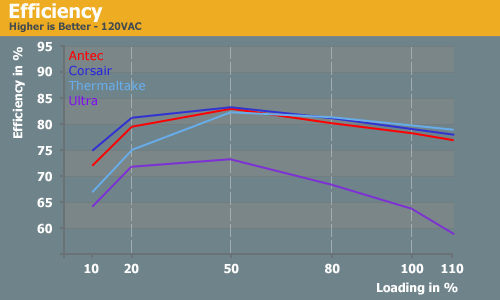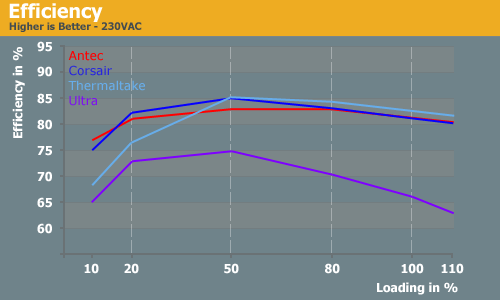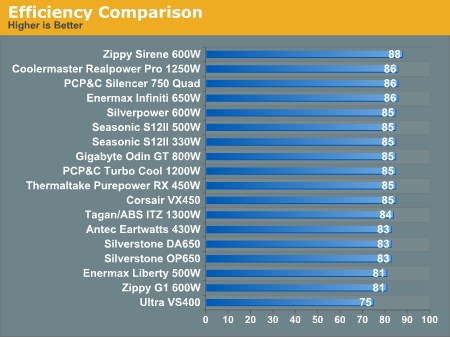400-450W PSU Roundup
by Christoph Katzer on November 6, 2007 4:00 AM EST- Posted in
- Cases/Cooling/PSUs
Comparison and Conclusion
Let's come to the interesting part of performance. The output stability has been quite similar from the three higher-end units. Thermaltake looks a little better than the others do, but all are well within specs. Ultra ends up as a very low-end unit and the results clearly show this better than any words.


In the area of efficiency, the Antec and Corsair units take the lead again. Both are at 80% efficiency starting with loads of around 90W while the two other are at 76% and 73%. The components in the Corsair PSU seem to be slightly better than the cost-reduced Antec PSU, as evidenced by the 1% higher efficiency. Still, 1% higher efficiency should not be the only reason for buying this unit since there are so many other points to keep in mind. Thermaltake does achieve a high 85% efficiency with a medium load of 225W as well.

In terms of connectors, the Corsair clearly has the most options and is the best-equipped PSU of the bunch. There are six Molex and six SATA connectors attached to four harnesses with a minimum length of 30cm and a maximum length of just 60cm. The ATX connector, PEG and CPU connectors have a length of 60cm as well which is nice and long. The corsair is the only unit today with an 8-pin EPS connector (not that it's really necessary for a 450W PSU).
When it comes to prices, it's no shock that the Ultra is the cheapest (by far!) of the four tested units, with prices as low as $40US. The V-Series 400W is not available in Europe because of the missing PFC. The Antec Earthwatts 430W comes next, with prices starting at $60. That may be 50% more than the Ultra, but we hope it's now clear that this is money well spent. Corsair and Thermaltake come in as the most expensive of this batch, with the Corsair 450VX selling for around $78 and the Thermaltake Purepower 450W going for a few dollars more ($84).
After looking at the test results, one of these power supplies clearly rises above the rest: the Corsair 450VX. It provided the best overall performance, it wins in the area of connector options (though not by a large amount), and it also provides the lowest noise levels. It's not perfect, as heatsink temperatures were still a bit higher than we'd like under stress conditions, but if you're after a high quality, moderate wattage power supply this one definitely ranks above the rest. The price is even acceptable. If you'd rather spend less than $60, while the Earthwatts isn't bad, we'd probably just go back to the source and pick up a Seasonic 380W unit.
Let's come to the interesting part of performance. The output stability has been quite similar from the three higher-end units. Thermaltake looks a little better than the others do, but all are well within specs. Ultra ends up as a very low-end unit and the results clearly show this better than any words.


In the area of efficiency, the Antec and Corsair units take the lead again. Both are at 80% efficiency starting with loads of around 90W while the two other are at 76% and 73%. The components in the Corsair PSU seem to be slightly better than the cost-reduced Antec PSU, as evidenced by the 1% higher efficiency. Still, 1% higher efficiency should not be the only reason for buying this unit since there are so many other points to keep in mind. Thermaltake does achieve a high 85% efficiency with a medium load of 225W as well.

In terms of connectors, the Corsair clearly has the most options and is the best-equipped PSU of the bunch. There are six Molex and six SATA connectors attached to four harnesses with a minimum length of 30cm and a maximum length of just 60cm. The ATX connector, PEG and CPU connectors have a length of 60cm as well which is nice and long. The corsair is the only unit today with an 8-pin EPS connector (not that it's really necessary for a 450W PSU).
When it comes to prices, it's no shock that the Ultra is the cheapest (by far!) of the four tested units, with prices as low as $40US. The V-Series 400W is not available in Europe because of the missing PFC. The Antec Earthwatts 430W comes next, with prices starting at $60. That may be 50% more than the Ultra, but we hope it's now clear that this is money well spent. Corsair and Thermaltake come in as the most expensive of this batch, with the Corsair 450VX selling for around $78 and the Thermaltake Purepower 450W going for a few dollars more ($84).
After looking at the test results, one of these power supplies clearly rises above the rest: the Corsair 450VX. It provided the best overall performance, it wins in the area of connector options (though not by a large amount), and it also provides the lowest noise levels. It's not perfect, as heatsink temperatures were still a bit higher than we'd like under stress conditions, but if you're after a high quality, moderate wattage power supply this one definitely ranks above the rest. The price is even acceptable. If you'd rather spend less than $60, while the Earthwatts isn't bad, we'd probably just go back to the source and pick up a Seasonic 380W unit.










37 Comments
View All Comments
zeroidea - Wednesday, November 7, 2007 - link
The Antec PS featured in this article is currently on sale at staples.com for $30.http://www.staples.com/webapp/wcs/stores/servlet/S...">Link
SilthDraeth - Wednesday, November 7, 2007 - link
I know it falls outside of the 450Watt max, but it is still below the 500 watt barrier. I just bought the psu for a midrange system I built my mom, I know it works well, but I don't have the ability to test everything.One can wish right?
Noya - Tuesday, November 6, 2007 - link
If you look around (buy.com), the Corsair 450vx can be had from $51-61 pretty regularly, and at that price it's untouchable. I must say I've had one for about two months and haven't had any problems with it.smthmlk - Tuesday, November 6, 2007 - link
Can we have a full list of caps in each unit? Noting the primaries is nice, but what about the others? Thanks.Talcite - Tuesday, November 6, 2007 - link
Thanks for finally putting up O-scope readings, it's quite nice to see them. One thing I'm concerned about though is the lack of explication or analysis.For example, is the entire o-scope range 200mV in the 12v readings or is it one division? Also, there's a number of strange spikes in all the o-scope readings. I'm pretty familiar with the 450VX o-scope readings (mostly from other sites) and I haven't noticed any spikes of that nature in their readings. It probably isn't, but is the equipment faulty?
Thanks for putting the readings up anyways though, they're a nice addition.
Super Nade - Tuesday, November 6, 2007 - link
Those strange spikes are probe noise. If the probe is coupled incorrectly, you will see this artifact. This cold be due to any number of factors like EMI for instance. Following the ATX guideline on using 0.1 uF output coupling caps will minimize this to a great extent.MrOblivious - Tuesday, November 6, 2007 - link
You have to look at the sampling time on the readings to compare between sites. Different sampling times will make the traces appear a bit different.phaxmohdem - Tuesday, November 6, 2007 - link
I just recently built a rig for a buddy using a Thermaltake PurePower (or ToughPower.. can't remember) 480W Unit and it works like a champ powering a Core2 Quad Q6600 CPU, 2GB RAM, 2HDD's, two Optical Drives, 8600GT, TV Tuner and a few fans. (Wish I knew about the Corsair PSU when I spec'd that system out).But yeah, Unfortunately most people equate Watts to overall quality.... not unlike the MHz war of days gone by. Power supplies are one of the hardest components to convince people to spend extra on for some reason. FFS, electricity is kind of the basis of the whole dam computer!
Eventually it ends up as "Oh well. Go ahead and get that 600W $30 power supply and let me know how that goes for ya. I could use a good laugh, and don't say I didn't warn you."
strikeback03 - Tuesday, November 6, 2007 - link
Maybe Anandtech should go ahead and list the weight of each PSU. That has long been used as an estimate of quality.jonnyGURU - Tuesday, November 6, 2007 - link
Not any more. Topologies have changed to the point where you can have very light quality units and very heavy crap. Weight is NOT a factor.